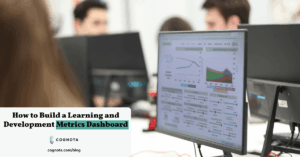As its name implies, a skills gap analysis is a process by which an organization determines what gaps exist between employees’ current skills and the skills considered necessary or even critical for the organization to reach its current and future goals.
This is no simple task. The process itself requires widescale participation and the results might paint an uneasy picture of employees’ current capabilities.
Nonetheless, a skills gap analysis can serve as a necessary blueprint from which to consider new courses, assessments, or support tools.
While a robust, well-executed training intake system—with course requests supplied by business partners—can inform L&D of which courses to consider developing, a skills gap analysis provides another view of an organization’s learning needs.
With this proof in hand, talent developers will have justification for moving forward with the development of certain courses that deliver the most impact.
It’s also worth noting that a skills gap does not necessarily mean the complete absence of a skill. For example, developers on the engineering team may possess the knowledge and experience of working with a particular programming language; however, they may not be aware of one particular code library that was launched last year. If a manager determines that that library is necessary for the development of the company’s software, then that lack of experience with that library would be considered a skills gap, even though the developer is skilled in the underlying language.
As such, a skills gap analysis can become tricky. It must measure existing vs. desired proficiency levels, and what the organization considers necessary for sustained or improved business performance.
Why you should conduct a skills gap analysis
From a human resources perspective, it makes sense to take an inventory of employees’ skills, But why is this important? Certain conditions, or even red flags, may indicate that it’s time. These might be because the organization is
- Losing sales to a competitor with a better product or service
- Experiencing a decrease in productivity and possible morale
- Assessing its external recruiting strategy
- Planning for the future
What challenges lie ahead for L&D in 2021 and beyond? Access our recorded webinar on safeguarding against uncertainty.
Some of these might seem vague, or perhaps too disconnected from day-to-day operations. However, learning leaders leverage the insights from managers and business partners to help them fully understand the correlation between a certain skill and a business outcome.

How to conduct a skills gap analysis
There are essentially three steps to conducting a skills gap analysis.
1. Define the skills the organization needs—now and in the future.
The first step in determining if a skills gap exists is figuring out what skills employees need in order for the organization to meet its business objectives now and in the future. These can include both technical skills and soft skills, and business objectives need to be mapped to these skills.
This is at the macro level, but the anticipated skills needs or “wish list” can be obtained from managers or business partners on the ground who have a much more thorough idea of what employees need to improve overall business performance.
L&D can also ask managers to look outside the company, in the industry in general, for additional insight into expected skills needs.
2. Assess your current workforce’s current skills.
The next step in conducting the skills gap analysis is to determine the skills the organization’s current workforce possesses. This can be accomplished by gathering data from the following sources:
- Performance reviews
- Skills assessments
- 360-degree feedback processes
- Self-evaluations
This can become quite extensive, especially for large organizations, and not all information from every employee might be available. However, leveraging feedback on skills from multiple sources gives a much more granular view of the skills of the organization.
3. Identify skills gaps.
After first defining the skills the organization needs and then measuring employees’ current skill sets, L&D can then identify where the skill gaps exist.
These gaps may need to be filled in the near term in order to accelerate productivity today, or the gaps may be filled in the medium term in order to set the organization up for success in the future. Indeed, “calendaring” these gaps can help in capacity planning so that L&D does not inundate itself with courses needing to be built.
For added impact and relevance, learning leaders can associate expected revenue or profitability measures to each skill. In doing this, they can demonstrate to senior leadership how a gap in that skill has a direct impact on the bottom line of the organization.

Next steps: implementation
Now that the skills gaps are known, L&D can begin to address them head on.
While the skills gap research and analysis might have uncovered glaring, mission-critical gaps that need to be addressed right now, there might be other gaps that leave L&D uncertain as to how and when to address them.
To do this, the team can consider the following aspects of a potential course aimed at closing that gap, and then determine what the next steps might be:
- How many employees will need to take the course?
- How long it will take to build the course?
- What resources are needed to build the course? Are there in-house subject matter experts to help with content?
- How long until the course needs to be updated and the employees retrained?
This can help in prioritizing training needs and preventing the L&D team from burning out.
Questions such as those above are not just questions to be asked after the completion of a skills gap analysis and the L&D team seeking more insight into the impact of a potential course. L&D asks these questions all the time, and the answers are usually provided by business partners when they enter a request in the company’s training intake system.
In fact, talent developers can have these questions in mind before they even begin the skills gap analysis. While this might seem like putting the cart before the horse, it can save time at the end and provide L&D with much-needed insights to justify and prioritize course development.
Planning for 2021 has never been more relevant or more crucial to the success of L&D.
Download our Learning and Development 2021 Strategy Toolkit today!




